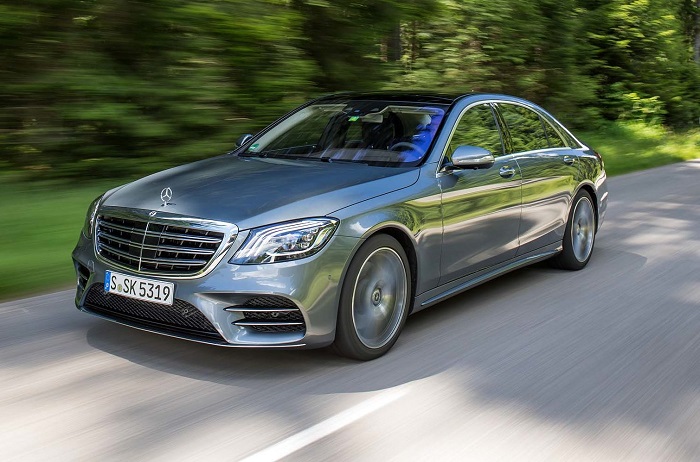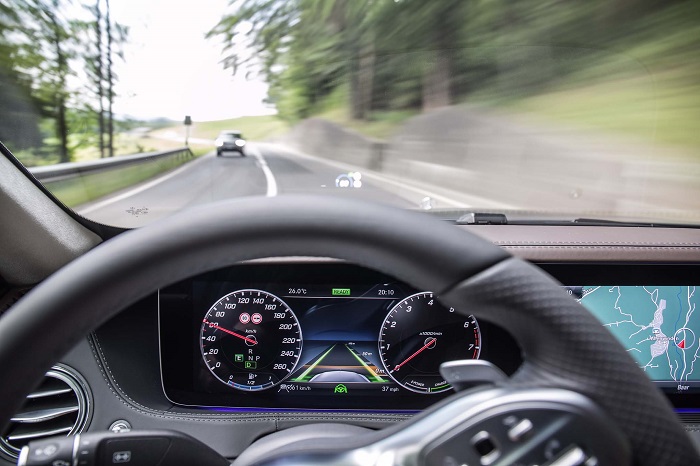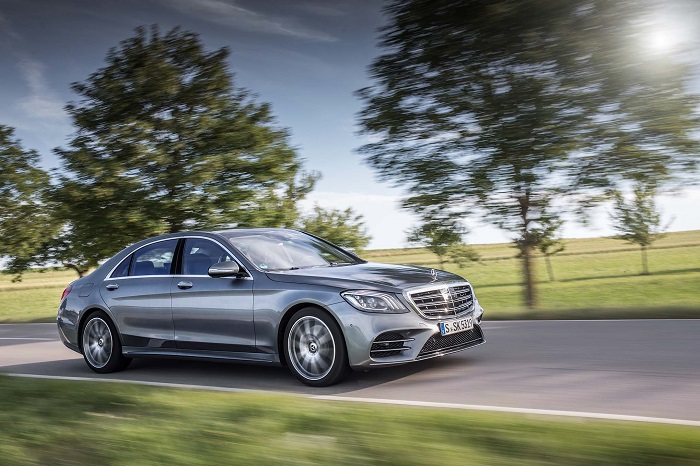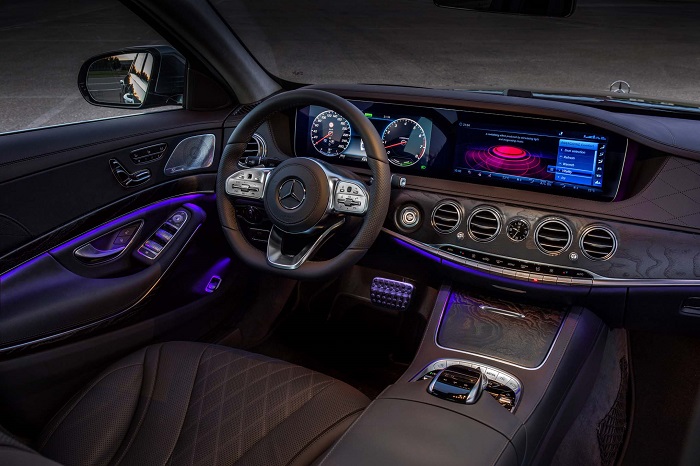There’s no doubt the electrification of the automobile is well under way.
However, the tipping point—that inflection point when more consumers choose to buy an electric vehicle over a gasoline powered one—is still a ways away. There are many reasons for this, but the most obvious one is infrastructure. There’s a gas station (or three) at every intersection. The electric car world, meanwhile, still hasn’t bothered to agree on a charging standard. 220-volt? 440-volt like Tesla Supercharger stations? 880-volt like Porsche says it’s doing with the Mission E? You tell me. We don’t yet know what the electric future will look like. For now it remains a chicken or egg scenario; which will come first—the cars or the infrastructure? I say who cares because I just drove the steak. Meet the blueprint for the immediate future of the internal combustion engine: the all-new Mercedes-Benz M256, the gasoline-powered version of the brand’s new inline-six, available (to some) in the new Mercedes-Benz S500.

This engine changes everything. Yes, as a certified (certifiable?) car guy, I’m digging the fact that Mercedes has dumped the fine but unlovable V-6 in favor of the layout that served them so well for so many years. Put into Animal Farm terms, inline-six good, V-6 bad. Or maybe like this: All six-cylinders are good, but some are more good than others. However, that’s not the big picture. This is: There are no belts. The M256 employs a 48-volt electrical system, so the AC compressor and water pump are electric. The alternator is integrated into the starter motor, both of which actually compromise a part called the Integrated Starter Generator, or ISG. It’s an electric motor wrapped around the crankshaft, sandwiched between the engine block and the transmission. There’s also an electric supercharger, as well as a conventional turbocharger. From a dead stop, and because electric motors provide 100 percent of their torque at zero rpm, the ISG instantly spins the crankshaft, giving the S500 a quick jump off the line. Even with the traction control fully enabled, you can chirp the rear tires.

At the same time, the electric supercharger is boosting the engine. The handoff between initial electric propulsion and gasoline power is seamless. It’s also not really a handoff because the ISG continues to do some work. Once engine revs are high enough and enough exhaust pressure has been built up to spin the turbocharger, a valve in the engine’s plumbing closes and starves the supercharger. However, during certain mid-rev duties, the electric supercharger assists the turbo, and the ISG is always there, lending a helping hand. Power is great—especially as this is the non-AMG version—rated at 435 horsepower and 384 lb-ft or torque.

Frankly that feels underrated, likely due to the tsunami of torque the 48-volt system enables. Remember, there’s no way to accurately state the combined torque from a hybrid. Electric motors make peak torque at 0 rpm, whereas twisting force for an internal combustion engine peaks at higher engine speeds. There’s also a weaker iteration of this engine found in the S450, which produces 367 hp and 369 lb-ft of torque. Also, there’s at least one AMG tune of the M256 coming. Also cool: Unlike almost every V-6 ever built, inline-sixes sound great, and AMG has a sound department. Mercedes says the S500 can hit 62 mph in 4.8 seconds, meaning 60 mph in 4.7-ish seconds, which is exactly what the old V-8 powered S550 did when we tested it.
At the urging of Oliver Vollrath, the engineer in charge of Mercedes’ six, eight, and 12-cylinder engines, I did something I never do: put the S500 into Eco mode. When cruising at a more or less constant, legal pace, the beltless engine constantly turns itself off and then on again. You know this is happening only because the tachometer needle drops to 0. Otherwise, the process is imperceptible. You cannot feel anything—I feel the need to stress this part, nothing—and because the S500 is a big, old luxo-barge S-Class in Eco mode, you can’t hear anything, either. It seems fake. We don’t know the fuel consumption for this engine on the U.S. cycle yet, but expect it to be better than the V-6. Mercedes claims the new I-6 puts out 22 percent less CO2 than the old 4.7-liter V-8.

When the engine turns off, the ISG keeps the transmission spinning or "sailing,” maintaining speed until the nearly 1-kilowatt-hour lithium-ion battery needs to be juiced or propulsion power is needed, and the engine is silently switches back on. Remember, the ISG is also the starter motor, and it’s already at work. Calling me impressed is an understatement. There is no shaking, no vibration, no nothing. I couldn’t believe it.
Right, so Mercedes-Benz has just breathed electric life into the internal combustion engine. Excited? Want to polka on down to your friendly neighborhood Mercedes-Benz dealer and buy one? Well guess what—you can’t! Mercedes is not giving the U.S. this car with this engine. Why not? A crowd of annoyed German engineers blamed it on "a stupid decision from the sales guys in the U.S.” Daimler board member Ola Källenius said Americans are much more interested in V-8s. Given the expense of launching a model—any model—Mercedes has decided to follow the money and stick with the V-8 S560 for now, and if price-conscious American S-Class buyers do exist, Mercedes will sell them an S450 with last year’s V-6 technology. You can’t necessarily fault the company for that. But I think it’s the wrong decision.

Source: motortrend.com

This engine changes everything. Yes, as a certified (certifiable?) car guy, I’m digging the fact that Mercedes has dumped the fine but unlovable V-6 in favor of the layout that served them so well for so many years. Put into Animal Farm terms, inline-six good, V-6 bad. Or maybe like this: All six-cylinders are good, but some are more good than others. However, that’s not the big picture. This is: There are no belts. The M256 employs a 48-volt electrical system, so the AC compressor and water pump are electric. The alternator is integrated into the starter motor, both of which actually compromise a part called the Integrated Starter Generator, or ISG. It’s an electric motor wrapped around the crankshaft, sandwiched between the engine block and the transmission. There’s also an electric supercharger, as well as a conventional turbocharger. From a dead stop, and because electric motors provide 100 percent of their torque at zero rpm, the ISG instantly spins the crankshaft, giving the S500 a quick jump off the line. Even with the traction control fully enabled, you can chirp the rear tires.

At the same time, the electric supercharger is boosting the engine. The handoff between initial electric propulsion and gasoline power is seamless. It’s also not really a handoff because the ISG continues to do some work. Once engine revs are high enough and enough exhaust pressure has been built up to spin the turbocharger, a valve in the engine’s plumbing closes and starves the supercharger. However, during certain mid-rev duties, the electric supercharger assists the turbo, and the ISG is always there, lending a helping hand. Power is great—especially as this is the non-AMG version—rated at 435 horsepower and 384 lb-ft or torque.

Frankly that feels underrated, likely due to the tsunami of torque the 48-volt system enables. Remember, there’s no way to accurately state the combined torque from a hybrid. Electric motors make peak torque at 0 rpm, whereas twisting force for an internal combustion engine peaks at higher engine speeds. There’s also a weaker iteration of this engine found in the S450, which produces 367 hp and 369 lb-ft of torque. Also, there’s at least one AMG tune of the M256 coming. Also cool: Unlike almost every V-6 ever built, inline-sixes sound great, and AMG has a sound department. Mercedes says the S500 can hit 62 mph in 4.8 seconds, meaning 60 mph in 4.7-ish seconds, which is exactly what the old V-8 powered S550 did when we tested it.
At the urging of Oliver Vollrath, the engineer in charge of Mercedes’ six, eight, and 12-cylinder engines, I did something I never do: put the S500 into Eco mode. When cruising at a more or less constant, legal pace, the beltless engine constantly turns itself off and then on again. You know this is happening only because the tachometer needle drops to 0. Otherwise, the process is imperceptible. You cannot feel anything—I feel the need to stress this part, nothing—and because the S500 is a big, old luxo-barge S-Class in Eco mode, you can’t hear anything, either. It seems fake. We don’t know the fuel consumption for this engine on the U.S. cycle yet, but expect it to be better than the V-6. Mercedes claims the new I-6 puts out 22 percent less CO2 than the old 4.7-liter V-8.

When the engine turns off, the ISG keeps the transmission spinning or "sailing,” maintaining speed until the nearly 1-kilowatt-hour lithium-ion battery needs to be juiced or propulsion power is needed, and the engine is silently switches back on. Remember, the ISG is also the starter motor, and it’s already at work. Calling me impressed is an understatement. There is no shaking, no vibration, no nothing. I couldn’t believe it.
Right, so Mercedes-Benz has just breathed electric life into the internal combustion engine. Excited? Want to polka on down to your friendly neighborhood Mercedes-Benz dealer and buy one? Well guess what—you can’t! Mercedes is not giving the U.S. this car with this engine. Why not? A crowd of annoyed German engineers blamed it on "a stupid decision from the sales guys in the U.S.” Daimler board member Ola Källenius said Americans are much more interested in V-8s. Given the expense of launching a model—any model—Mercedes has decided to follow the money and stick with the V-8 S560 for now, and if price-conscious American S-Class buyers do exist, Mercedes will sell them an S450 with last year’s V-6 technology. You can’t necessarily fault the company for that. But I think it’s the wrong decision.

Source: motortrend.com
Latest News


